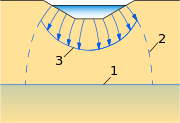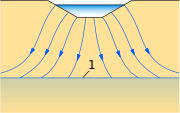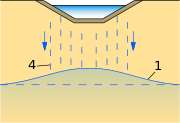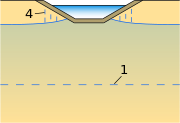
Water losses in canals and their estimation. All irrigation water losses can be broken down into separate groups as follows:
1) water losses to seepage and evaporation from water surface from irrigation canals;
2) water losses to seepage and evaporation from the irrigated field;
3) operational losses, leakage and escapage from canals;
4) in-process losses.
The losses from irrigation canals are the greatest in the system; they much influence on the performance of canals and the whole system. When designing, these losses are determined based on estimation.
When estimating water losses to seepage from irrigation canals, two principal cases should be taken into consideration:
1) canals operate for a long time;
2) canals operate intermittently (on-farm distributors).
Impermeable membranes (screens) and seepage-control lining on irrigation canals. Seepage-control lining, waterproofing finishing and watertight barriers made from natural soil, petroleum asphalt and plastic films are provided for the purpose of diminution (prevention) of water losses to seepage from irrigation canals. Rigid lining is made from concrete, precast or cast-in-situ reinforced concrete.
The water sheet lost through the canal’s wetted perimeter per day serves as a criterion for the assessment and selection of seepage-control measures. If a water sheet of more than 30 cm is lost from the canal, seepage-control measures are to be implemented without fail; if the lost water sheet is 5-10 cm, then the canal operates satisfactorily.
Operational and structural measures are implemented with the view of reducing water losses from canals.
Operational measures: scheduled water use; shortening of the irrigation network extension (especially on-farm network); timely maintenance and cleaning of canals; and other measures aimed to improve conditions of the irrigation network.
Structural measures: installation of different seepage-control lining as well as measures for changing the penetration capacity (filterability) of the canal bed ground; use of piped network.
Diverse natural and economic conditions of irrigated areas made for the use of different designs of seepage-control lining on irrigation canals. The most widespread are linings made from cast-in-situ concrete, precast concrete slabs, concrete-film and ground-film coatings. Flume-type channels are also used. Canals (or some canal sections) may have no lining if they are built on low-permeable soils that are resistant to erosion and creeping.
Water losses from canals take place both due to its evaporation from the surface of open canals and its seepage through canal walls and bottom. At that, in most cases evaporation losses are quite insignificant, whereas seepage losses can reach very large quantity which considerably lowers the canal cost-performance. Additionally, flooding of the neighboring soil may cause waterlogging of the area; on subsiding (collapsible) soil, may bring to canal deformation and breakup of structures; in mountains, to dangerous failures and mudflows.
|
Types of canal water seepage | |||
Without backwater in an unlined canal |
With backwater in an unlined canal |
Without backwater in a lined canal |
With backwater in a lined canal |

|

|

|

|
1 — initial groundwater level |
|||
Two stages of seepage are discerned as follows: free and with backwater. With seepage from non-free-surface zone with backwater, seepage flow from canal contacts the groundwater and is backed-up by the latter.
Seepage can be controlled by lining of the canal bottom and bed, as well as by decreasing bed ground permeability; this can be realized by mechanical sealing or mud grouting (colmatage), i.e. filling of soil pores with minor particles; for example, colmatage with clay or muddy soils can be applied for sandy ground. The method of addition of special materials into the canal ground is a particular method of lowering of permeability. This method includes artificial alkalinization of ground, artificial gleization, petrolization, etc.; however, these methods cause pollution of water stream.
Sources: Wikipedia, skyrage.ru